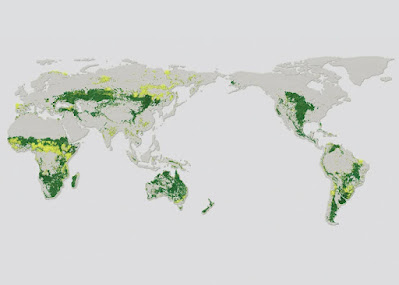By Lauren Kent
Rochester, England - Forests have long been celebrated (click here) as the natural heroes in the fight against the climate crisis. They are so good at absorbing and storing carbon dioxide, a consortium of environmental groups are calling on the world to plant one trillion trees over the next decade.
But while we are looking up at the treetops for climate solutions, some campaigners are urging the world to look down, where another answer lies -- right under our feet.
Forests, peatlands, deserts and tundra can all absorb and hold stocks of carbon-dioxide (CO2). Of all the carbon held in land-based ecosystems, around 34% can be found in grasslands, data from the World Resources Institute show. That's not much less than the 39% held in forests.
"Whether you look at the Serengeti, the Cerrado in Brazil, whether you look at what's left of the prairies in North America or the steppes of Mongolia -- every single one of our major, iconic grassland habitats is under threat at the moment," Ian Dunn, chief executive of the British conservation organization Plantlife, told CNN.
There's also plenty of it in the United Kingdom, which will host world leaders and climate negotiators in just over a week at the COP26 climate talks in Glasgow, Scotland. Among several items on the agenda is how to protect forests and plant more trees to help slash global emissions.
But Plantlife, among other groups, is campaigning for grasslands to be protected at an international level and part of any deal that emerges in Glasgow....
But while we are looking up at the treetops for climate solutions, some campaigners are urging the world to look down, where another answer lies -- right under our feet.
Forests, peatlands, deserts and tundra can all absorb and hold stocks of carbon-dioxide (CO2). Of all the carbon held in land-based ecosystems, around 34% can be found in grasslands, data from the World Resources Institute show. That's not much less than the 39% held in forests.
"Whether you look at the Serengeti, the Cerrado in Brazil, whether you look at what's left of the prairies in North America or the steppes of Mongolia -- every single one of our major, iconic grassland habitats is under threat at the moment," Ian Dunn, chief executive of the British conservation organization Plantlife, told CNN.
There's also plenty of it in the United Kingdom, which will host world leaders and climate negotiators in just over a week at the COP26 climate talks in Glasgow, Scotland. Among several items on the agenda is how to protect forests and plant more trees to help slash global emissions.
But Plantlife, among other groups, is campaigning for grasslands to be protected at an international level and part of any deal that emerges in Glasgow....
By Kaitlin Sullivan
Global cleanups pull plastic from oceans (click here) and pledge drives guard rainforests, but grasslands get very little love. Only 5 percent of Earth’s remaining meadows are preserved, making them the least-protected biome.
Humans have already destroyed more than 90 percent of the planet’s grass, most of it to produce our food: Grazing alone takes up one-quarter of all land. What’s left is fragile because grasslands’ seasonality makes them vulnerable to climatic changes in precipitation and temperature. This is what remains....
